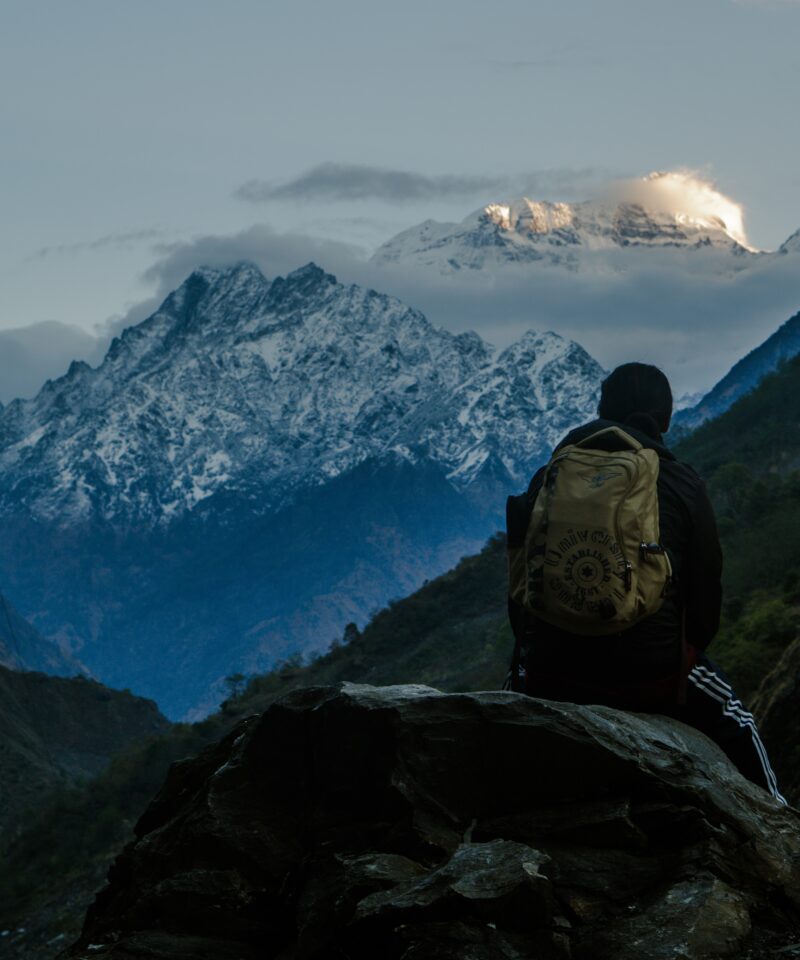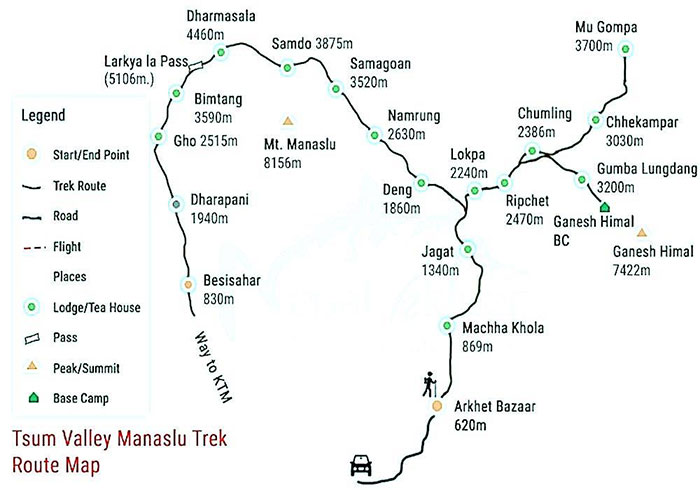Introduction and Overviews:
Mt. Manaslu Circuit Trekking takes you around on restricted region of Nepal Far North Mid-West Himalaya within remote north Gorkha district to high scenic valley of upper Manaslu and traverse over Larke-La to reach at another mountain region in Manang.
Mt. Manaslu Circuit Trekking been opened for outside visitors since last end of 20th century 1990’s where trekkers are allowed on paying extra fees to explore and venture on this scenic and beautiful valley of high Manaslu.
Mt. Manaslu listed as world eighth tallest peak at the height of 8,163 m and 26, 781 ft high located between massive Annapurna and Ganesh Himal Mountain range, which makes this adventure more spectacular overlooking great array of Nepal Mid-West Himalayan peaks.
The mountain was first explored and conquered by Japanese Expedition with support of Nepalese climbers in May 09th 1956, since then the area remain closed till it was allowed last past decades.
Mt. Manaslu Circuit Trekking leads you with enjoyable and marvelous walks from the start to an end of trekking, where adventure begins after taking a long and exciting overland journey to reach at warm low valley within Gorkha district.
Around heavily farmed area of sub-tropical climate then follow the raging Burigandaki River upstream reaching almost to its glacial source around high Manaslu valley, walk from low warm farms to reach around cooler alpine temperatures.
As journey proceeds entering many nice and lovely villages where you can catch immense local hill village culture of traditional farm life, as route leads higher walking within serene woods of tall rhododendron, oaks, blue pines and fir trees.
An impressive walks overlooking grand scenery of rolling green hills, deep valley and gorge with high snow capped peaks Pang Phuchin 6,335m, Saula Himal 6,235m with many several unnamed peaks that rises above 6,000 m high includes views of massif Ganesh Himal towards east direction.
As walk reaches higher hills where temperatures gets much cooler on reaching closer around mountainous area of Mt. Manaslu, where local native of Manaslu knows by the name ‘Kutung’ a lovely place, where the word Manaslu derived from ancient Sanskrit means ‘Manas’ mind and soul of gods, like holy lake Manasrover in Tibet near Mt. Kailash.
Adventure finally takes you around high Manaslu valley enclosed by array of peaks with time to explore its interesting villages of Namrung, Bhi-Gaon, Lo and Sama-Gaon interwoven with strong Buddhism religion and culture to Tibetan, where the border of Tibet falls close from Manaslu valley.
In ancient times where busy trade use to take place on this old Trans-Himalaya Caravan and Salt Trade Route of Nepal and Tibet, at present bartering and trade still exists but in smaller numbers.
On reaching the main village of Sama-Gaon which is also on route to Mt. Manaslu base camp that takes about 2-3 days walks heading southward from the village, while in Sama-Gaon most trekkers spends extra leisure days for short hike and exploring the village impressive culture.
Staying for two overnights at Sama-Gaon at 3,550 m helps and supports acclimatization before heading towards high Larke-La Pass which is the highest spot of the adventure of above 5,160 m and 16,929 ft high.
Around Sama-Gaon and walks enjoy over-looking Peak 29 ahead, with excellent views of Phungi includes great range of Mt. Manaslu and Himal Chuli with Bouddha Himal.
Enjoying pleasant and scenic, cultural time at Sama-Gaon and observing fascinating colorful custom, then getting ready for the Big Day to cross over Larke-La Pass, where route leads to the last village Samdu of Manaslu valley.
From Samdu leaving the very end of Manaslu valley and Gorkha area village to reach on the foot and base of Larke-La Pass, called Dharmasala or Phedi (bottom of a hill), in earlier days called Larke Bazaar, where busy market were held once a week where merchants and traders from Nepal and Tibet used to sell and exchange their products including crops and spices.
Adventure ends on crossing over high Larke-La pass from Manaslu to Manang district:
After last overnight stop around Gorkha and at final end of beautiful Manaslu high valley, early morning climb takes you to steep haul past few huts and shades of Dharmasala area, following the lead guide to cross over an ablation of Larke Peak North glacier, along with views of Cho and Larke Peak to reach on top Larke-La at 5,160 m high.
The top of Larke marked with a sign name and height of the pass, festooned with hundreds of colorful Buddhist prayer flags and with stone crain as a marker, where in heavy snow condition will be much strenuous and arduous job to find the right path.
At the top rewards you with stunning panorama of mountain range with Manaslu, northern peaks of Annapurna with Ganesh towards Far East direction includes views of Manang Himal with Himlung, Cheo Himala, Kang-Guru
After overlooking mind-blowing scenery of high peaks with dramatic landscapes, crossing Larke-La and over to reach around Manang district, with long descend on downhill past a small place of Larcia, as walks lead over a moraine ridge to reach Tambuche at 3,900 m on reaching bottom of Larke-La pass, within back into green vegetation and tall trees lines.
From here after a tiring day of the adventure walk for another hour to reach at beautiful place in Bhimthang for overnight, a lovely wonderful spot on green wide valley with prayer Mani walls in the midst of beautiful rhododendron-pines and oak forest.
Bhimthang provides number of good lodges for overnight stay after a long day with an adventure over high Larke-la Pass, enjoying sound rest with refreshing overnight stop where walk takes you into serene woodland to reach at raging Masrsyangdi River.
On reaching Teje village located on the bank of River Masrsyangdi a short steep climb to beautiful large village at Dharapani, where famous popular Annapurna and Manaslu Circuit trail joins.
After last night stop in Dharapani with options, if time is limited can take a drive on jeep or four-wheel drive to Besisar large town and district of Lamjung area and then head to Kathmandu or Pokhara.
Trekkers with more time with few days to spend around hills of Nepal enjoy walks to reach on the foot hills at Syange near Masrsyangdi River after walking past Tal-Besi, Chamje and another Jagat village with downhill to reach Syange a small farm village.
From Syange drive takes you on good exciting road back to Kathmandu or one can head to scenic Pokhara city.
More Information on Mt. Manaslu Circuit Trekking:
To join in for Mt. Manaslu Circuit Trekking where trekkers require special permit to enter into high Manaslu valley and around, where all travelers need to join with proper Government authorized Trekking Agencies in Kathmandu or at Pokhara.
Where the company will obtain necessary permits for Manaslu treks and as well with other entrance for Conservation and National Park fees as well provides you with Nepal Government licensed guide to show you the trail and offering information of the area on route walks.
Mt. Manaslu Circuit Trek can be done combing with Tsum Valley treks where from last village of Jagat and Deng heading more east-ward and within back of massive Ganesh Himal to reach the valley of Happiness around Tsum then back on the trail of Manaslu circuit trek.
Few adventurers and trekkers seldom use clock-wise routes from Dharapani to cross Larke-La pass and to end around high Manaslu valley and back to Soti-Khola or Arughat Bazaar to end the treks.
Most travelers and trekking company use the normal anti-clock wise route from Gorkha towards Manaslu and to end the trek at Manang or around Lamjung district.
Best season for Mt. Manaslu Circuit Trekking:
March to May much preferred months for this trek around Manaslu, where days are fine and clear for views and walks with longer sunlight hours due to spring season, and flowers in bloom especially the rhododendron various species from tall trees to bush.
During March to May most days are fine, where some days can be cloudy and overcast late afternoon times, cooler morning and night time expect light rains and snow sometimes around higher side of Manaslu valley on the pass.
Another best time is autumn / fall season from September to early November months, when most days are crystal clear for excellent views of mountain range as well for pleasant walks.
Autumn months of September to early November with clear fine days most of the morning till late afternoon, but with short sun-light hours can be much freezing cold can expect snow on higher areas including on crossing Larke-La Pass.
From November onward most villages with nice lodge will be shut and closed as villagers of high Manaslu valley migrates to lower warm country to escape the harsh winter cold.
Culture and Religion:
On this walk Mt. Manaslu Circuit in the beginning where you find mix hill tribes of Magar, Gurung, Tamang with some Newar includes Hindu Bharamins, Chettries and Dalits of both Hindu and Buddhism religion with fascination custom and traditional farm life.
As walk takes you from Jagat village higher enter villages with more Buddhism religion and interesting cultures with native similar to Tibetan including traditional farm life, where one can visit monasteries of Lo-Gaon and at near Sama-Gaon.



